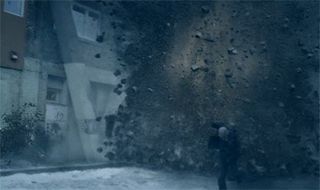Tom Clancy's Ghost Recon: Future Soldier
Seemingly sci-fi tech is based on real-world military prototypes
The build we were shown was very early, and illustrated one of the opening missions – a foray into Norway. A series of crippling cyber attacks, which had limited the States’ ability to see what was going on in Russia, had been identified as emanating from the land of the fjords. Enter new man Kozak (allegedly Scott Mitchell with added personality) and his team to ‘sort things out’. Later on, we witnessed a multiplayer level that was almost certainly Afghanistan, replete with obligatory stone huts and sinister cave network.
While both levels lacked the polish of a finished game, the action was running at60fps on an advanced iteration of GRAW’s YETI engine. Notably, it also sported a bold palette of bright blues, greens and whites – a far cry from the oranges, yellows and khakis that the GRAWs were composed of. (Intriguingly, the Cross Com HUD was entirely absent, though we were later reassured that it simply “hadn’t been added yet.”)
Even better, Ubisoft is laudably promising to maintain this spanking visual quality through single and multiplayer, as well as a “seamless transition” between the two modes. That means single-player, split-screen, jump in/jump out co-op – quite possibly for up to four players. Bonus. Also expect bigger explosions than ever -no mean feat considering GRAW pulled off some of the most memorable kaboom in the business in 2007.

As for the plot? Well, it’s typical pseudo-future territory – a “techno thriller with a Clancy level of detail”, to quote Ubi – even if the aged Mr C isn’t directly involved in writing duties. Pesky Russian ultra-nationalists have abducted the legitimate President, and invaded Northern Europe to boot. The US and what remains of the loyal Ruskie army leap into action, and the scene is set for another jingoistic, ever-so-morally-patronising globetrotting adventure packed with fun shooty bits.
Interestingly, Kozak’s Cross Com will no longer relate titbits of story info; instead, Ubisoft Paris wants Future Soldier to convey the ‘humanity of war’. To that end, you’ll see the story unfold through the eyes of its various protagonists. Examples cited included a Kremlin-based mission as a Russian Presidential bodyguard attempting to foil his abduction, or as a brave civilian defending his hometown from invasion. Lacey and Dauba assured us these won’t just be inconsequential titbits, but fully fleshed-out levels – if not quite as long as the Ghost scenarios.
Granted, it all sounds very Modern Warfare – but if you’ve ever read one of Tom Clancy’s Bible-long thrillers you’ll know the man himself was weaving first- and third-person narratives together when Grant Collier and his Infinity Ward strike team were still wearing their varsity jackets. “The overall geopolitical stuff, the tale of the terrorists – we really wanted to make more of this,” stresses Lacey.

“We told a good story in GRAW, but perhaps it didn’t let you focus on the true events. Now we let you physically play the plot, you’ll understand it more, plus it’ll inform your attitude towards the enemy – make you really want to take them down.” Even better, it also means the devs get to mollify fans who like their weapons ‘real world’ – their loadout of approximately 45 firearms will include classics like AK-47s and AN-94s, not just fancy stuff like SCAR-Ls.
Sign up to the GamesRadar+ Newsletter
Weekly digests, tales from the communities you love, and more
Recognising that no game so far – not even GRAW – has really nailed the squad mechanic, the Paris team moves onto their second massive reveal. First of all, they set the scene – expounding upon the real-life function of the squad. Spec Ops live, train and (sometimes) die together. They’re a band of brothers with a hive mind and are constantly aware there’s no room for mistakes.
Ubi wants to transfer this synergy to Future Soldier while keeping it as simple as possible. Using the metaphor of pro-gamer clans, they claim they’re consigning squad babysitting to the history books. Their baby? The Link-Up system. Okay, so Future Soldier technically isn’t the first game to sport this mechanic – Army of Two beat them to the punch there – but this is a much more refined evolution, and here’s how it works...
Most Popular




